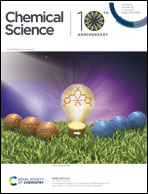Testing the limits of radical-anionic CH-amination: a 10-million-fold decrease in basicity opens a new path to hydroxyisoindolines via a mixed C–N/C–O-forming cascade†
Abstract
An intramolecular C(sp3)–H amidation proceeds in the presence of t-BuOK, molecular oxygen, and DMF. This transformation is initiated by the deprotonation of an acidic N–H bond and selective radical activation of a benzylic C–H bond towards hydrogen atom transfer (HAT). Cyclization of this radical–anion intermediate en route to a two-centered/three-electron (2c,3e) C–N bond removes electron density from nitrogen. As this electronegative element resists such an “oxidation”, making nitrogen more electron rich is key to overcoming this problem. This work dramatically expands the range of N-anions that can participate in this process by using amides instead of anilines. The resulting 107-fold decrease in the N-component basicity (and nucleophilicity) doubles the activation barrier for C–N bond formation and makes this process nearly thermoneutral. Remarkably, this reaction also converts a weak reductant into a much stronger reductant. Such “reductant upconversion” allows mild oxidants like molecular oxygen to complete the first part of the cascade. In contrast, the second stage of NH/CH activation forms a highly stabilized radical–anion intermediate incapable of undergoing electron transfer to oxygen. Because the oxidation is unfavored, an alternative reaction path opens via coupling between the radical anion intermediate and either superoxide or hydroperoxide radical. The hydroperoxide intermediate transforms into the final hydroxyisoindoline products under basic conditions. The use of TEMPO as an additive was found to activate less reactive amides. The combination of experimental and computational data outlines a conceptually new mechanism for conversion of unprotected amides into hydroxyisoindolines proceeding as a sequence of C–H amidation and C–H oxidation.

- This article is part of the themed collections: Celebrating 10 years of Chemical Science and New reactivity in organic chemistry


 Please wait while we load your content...
Please wait while we load your content...